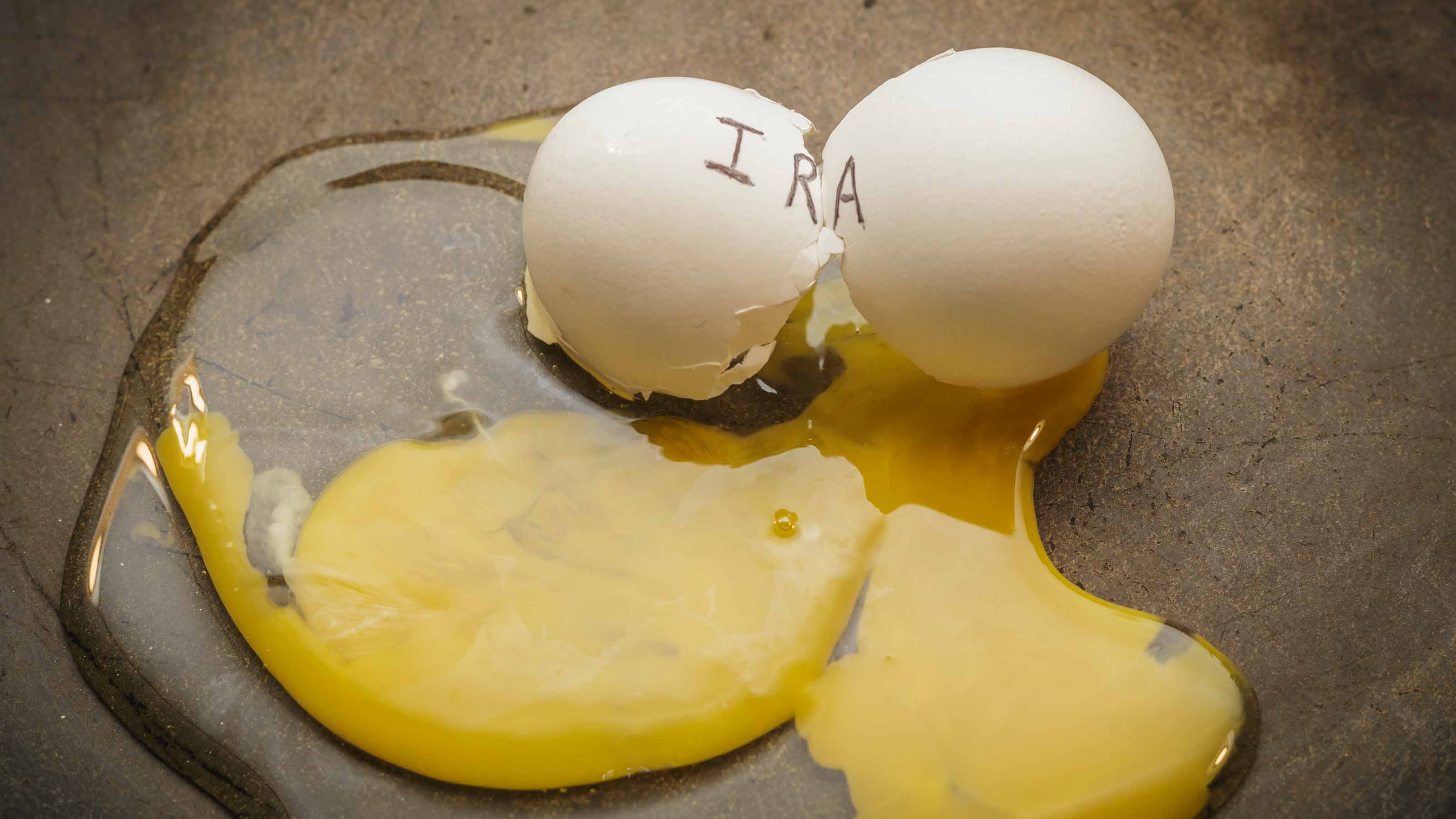Don't Make These Common IRA Mistakes
IRA expert Ed Slott walks us through common IRA mistakes and missed opportunities that you can avoid.


Millions of Americans use both traditional and Roth IRAs to save for retirement. But that doesn't mean they all have a full understanding of how IRAs work. As a result, mistakes are made, and opportunities are lost. To help you sidestep some of the most common blunders and get the most out of your IRA investments, we asked nationally renowned IRA guru Ed Slott, founder of IRAHelp.com, about the most common blunders and how to avoid them.
Not Planning for the "Second Half"
Slott sees retirement planning as a game with two halves. You accumulate wealth in the first half and withdraw it in the second. "Many people only play the first half of the game" and concentrate solely on stashing away as much money as possible in their IRA, Slott says. But with retirement saving, "it's not how much you have; it's how much you can keep after taxes."
With traditional IRAs, "you're really growing an account that will one day be shared with the government at some future tax rate, which may be higher because we're in really low rates right now," Slott notes. To prepare for the second half of retirement, it's important to "have a plan to get that money out at the lowest possible tax costs." And you should start the plan as soon as you put money in an IRA or other retirement account.
From just $107.88 $24.99 for Kiplinger Personal Finance
Become a smarter, better informed investor. Subscribe from just $107.88 $24.99, plus get up to 4 Special Issues

Sign up for Kiplinger’s Free Newsletters
Profit and prosper with the best of expert advice on investing, taxes, retirement, personal finance and more - straight to your e-mail.
Profit and prosper with the best of expert advice - straight to your e-mail.
Converting to a Roth All at Once
If you think your tax rate will be higher when you retire than it is right now, converting a traditional IRA to a Roth IRA this year might be a good idea. In the end, the total tax you owe on those funds may be lower by taking that step (e.g., future growth will be tax-free). A Roth conversion, however, comes with a tax bill on your next return – which scares off some people.
But the "mistake" those people sometimes make is thinking that they have to convert the entire account at once. "You can do partial conversions," says Slott. "It's not all or nothing." A good plan for many people is to "start a series of smaller, annual conversions over time, so little by little you're whittling down the growing tax bill in your IRA and building up in tax-free territory in a Roth."
Exceeding Roth IRA Income Limits
There are annual contributions limits for both traditional IRAs and Roth IRAs ($6,000, or $7,000 if you're age 50 or older, for 2022). However, for Roth IRAs only, there are also income limits. If you're single, the amount you can contribute to a Roth IRA in 2022 is gradually reduced to zero if your modified adjusted gross income is between $129,000 and $144,000 ($204,000 to $214,000 for joint filers).
Since IRA administrators generally send an alert if you go over the annual contribution limit, Slott says exceeding the basic limit isn't a problem for most people. However, with the Roth IRA income limits, it's easier to get into trouble because the administrator doesn't know your income and, therefore, can't warn you when you exceed the cap. So, it's up to you to keep track of the Roth income limits. If you're over the limit and still put money in a Roth IRA, you could be hit with a 6% penalty on any excess contributions. If you make that mistake, you may be able to avoid the penalty either by timely withdrawing the excess funds or recharacterizing your payment as a traditional IRA contribution.
Doing Indirect Rollovers
A lot of people get in trouble when they try to move money from one retirement account to another. If you take money out of an IRA and the check is in your name, you have 60 days to roll that money over into another retirement account before the withdrawn funds are deemed taxable income. That's called an indirect rollover. Plus, for IRA-to-IRA transfers, you can only do one indirect rollover per year.
"Nobody should be doing those kinds of rollovers," warns Slott. Instead, "you should be doing only direct rollovers, where the money moves from one retirement account to another directly, without anyone touching the money in between." If you don't do a direct rollover, and you miss the 60-day mark or violate the one-rollover-per-year rule, you could have a taxable distribution, be hit with a 6% excess contributions penalty, or even be forced to pay a 10% fine if you're under 59½ years of age. "The answer is to do direct rollovers," advises Slott, "but most people don't know that, and they take a check."
Forgetting to Account for All RMDs
You must start taking required minimum distributions (RMDs) once you reach 72 years of age. This is a "big problem area," according to Slott. For instance, people sometimes miss an RMD or don't take it for all of their accounts that are subject to the RMD rules. Other people miscalculate and don't withdraw enough money. These can be costly mistakes, because you could be stuck with a 50% penalty for violating the RMD rules – that's one of the largest penalties in the tax code. Fortunately, Slott notes, the penalty is "rarely assessed and it's easy to get waived if you make a mistake."
In some case, seniors who are still working can delay taking RMDs from the 401(k) account set up by their current employer. However, some people who work past age 72 mistakenly assume that this delay rule also applies to other retirement accounts. "It never applies to IRAs," Slott warns. It also doesn't apply to 401(k) plans from other employers.
Another common misconception is that you can do a Roth conversion before taking your annual RMD. That's a no-no, says Slott, "RMDs can never be converted to a Roth." You must take your RMD first, and then you can convert all or part of the remaining balance. In fact, "the first dollars out of your IRA each year are deemed to satisfy the RMD," according to Slott. His advice: Start your Roth conversions early, so everything is converted before you reach age 72. Then you won't have any RMDs to worry about.
Ignoring QCDs
Charitable-minded seniors who don't take qualified charitable distributions (QCDs) are missing out on a great opportunity, notes Slott. If you're at least 70½ years old, you can use a QCD to save on taxes by transferring up to $100,000 per year directly from a traditional IRA to charity. That money doesn't count as taxable income, but it does count towards your RMD. Plus, you can donate through a QCD even if you take the standard deduction.
Most people don't get any tax benefits from their charitable gifts because they don't itemize and, therefore, can't claim the charitable tax deduction. "The QCD is a way to get better than a tax deduction – you get an exclusion from income," says Slott. "Remember, the key to the IRA is to get the money out at the lowest rate. With the QCD, you're getting it out at a 0% tax rate."
Choosing the Wrong Financial Advisor
Finally, Slott recommends working with a financial advisor who has specialized training on the tax laws for retirement account distributions. (You can find a Slott-trained advisor at IRAHelp.com/find-an-advisor.) "The tax rules for getting money out [of an IRA] are among the most complex in the tax code, and the most unforgiving," warns Slott. "Make a mistake and it's very tough to fix it."
Profit and prosper with the best of Kiplinger's advice on investing, taxes, retirement, personal finance and much more. Delivered daily. Enter your email in the box and click Sign Me Up.
Rocky Mengle was a Senior Tax Editor for Kiplinger from October 2018 to January 2023 with more than 20 years of experience covering federal and state tax developments. Before coming to Kiplinger, Rocky worked for Wolters Kluwer Tax & Accounting, and Kleinrock Publishing, where he provided breaking news and guidance for CPAs, tax attorneys, and other tax professionals. He has also been quoted as an expert by USA Today, Forbes, U.S. News & World Report, Reuters, Accounting Today, and other media outlets. Rocky holds a law degree from the University of Connecticut and a B.A. in History from Salisbury University.
-
 Forget FIRE: Why ‘FILE’ Is the Smarter Move for Child-Free DINKs
Forget FIRE: Why ‘FILE’ Is the Smarter Move for Child-Free DINKsHow shifting from "Retiring Early" to "Living Early" allows child-free adults to enjoy their wealth while they’re still young enough to use it.
-
 7 Tax Blunders to Avoid in Your First Year of Retirement
7 Tax Blunders to Avoid in Your First Year of RetirementA business-as-usual approach to taxes in the first year of retirement can lead to silly trip-ups that erode your nest egg. Here are seven common goofs to avoid.
-
 How to Plan for Social Security in 2026's Changing Landscape
How to Plan for Social Security in 2026's Changing LandscapeNot understanding how the upcoming changes in 2026 might affect you could put your financial security in retirement at risk. This is what you need to know.
-
 10 Cheapest Places to Live in Washington
10 Cheapest Places to Live in WashingtonProperty Tax Is Washington your go-to ski destination? These counties combine no income tax with the lowest property tax bills in the state.
-
 3 Major Changes to the Charitable Deduction for 2026
3 Major Changes to the Charitable Deduction for 2026Tax Breaks About 144 million Americans might qualify for the 2026 universal charity deduction, while high earners face new IRS limits. Here's what to know.
-
 Retirees in These 7 States Could Pay Less Property Taxes Next Year
Retirees in These 7 States Could Pay Less Property Taxes Next YearState Taxes Retirement property tax bills could be up to 65% cheaper for some older adults in 2026. Do you qualify?
-
 Estate Tax Quiz: Can You Pass the Test on the 40% Federal Rate?
Estate Tax Quiz: Can You Pass the Test on the 40% Federal Rate?Quiz How well do you know the new 2026 IRS rules for wealth transfer and the specific tax brackets that affect your heirs? Let's find out!
-
 5 Types of Gifts the IRS Won’t Tax: Even If They’re Big
5 Types of Gifts the IRS Won’t Tax: Even If They’re BigGift Tax Several categories of gifts don’t count toward annual gift tax limits. Here's what you need to know.
-
 The 'Scrooge' Strategy: How to Turn Your Old Junk Into a Tax Deduction
The 'Scrooge' Strategy: How to Turn Your Old Junk Into a Tax DeductionTax Deductions We break down the IRS rules for non-cash charitable contributions. Plus, here's a handy checklist before you donate to charity this year.
-
 Are You Middle-Class? Here's the Most Tax-Friendly State for Your Family
Are You Middle-Class? Here's the Most Tax-Friendly State for Your FamilyTax Tips We found the state with no income tax, low property tax bills and exemptions on groceries and medicine.
-
 Social Security Benefits Quiz : Do You Know the IRS Tax Rules?
Social Security Benefits Quiz : Do You Know the IRS Tax Rules?Quiz Social Security benefits often come with confusing IRS tax rules that can trip up financially savvy retirees and near-retirees.
